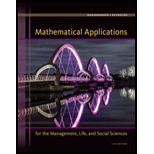
Concept explainers
In problems 15-22, simplify by combining like terms.
Want to see the full answer?
Check out a sample textbook solution
Chapter 0 Solutions
Mathematical Applications for the Management, Life, and Social Sciences
- 1.5. Run Programs 1 and 2 with esin(x) replaced by (a) esin² (x) and (b) esin(x)| sin(x)|| and with uprime adjusted appropriately. What rates of convergence do you observe? Comment.arrow_forwardIs the function f(x) continuous at x = 1? (z) 6 5 4 3. 2 1 0 -10 -9 -7 -5 -2 -1 0 1 2 3 4 5 6 7 8 9 10 -1 -2 -3 -4 -5 -6 -7 Select the correct answer below: ○ The function f(x) is continuous at x = 1. ○ The right limit does not equal the left limit. Therefore, the function is not continuous. ○ The function f(x) is discontinuous at x = 1. ○ We cannot tell if the function is continuous or discontinuous.arrow_forwardUse Taylor Series to derive the entries to the pentadiagonal and heptadiagonal (septadiagonal?) circulant matricesarrow_forward
- Is the function f(x) shown in the graph below continuous at x = −5? f(x) 7 6 5 4 2 1 0 -10 -9 -8 -7 -6 -5 -4 -3 -2 -1 0 1 2 3 4 5 6 7 8 9 10 -1 -2 -3 -4 -5 -6 -7 Select the correct answer below: The function f(x) is continuous. ○ The right limit exists. Therefore, the function is continuous. The left limit exists. Therefore, the function is continuous. The function f(x) is discontinuous. ○ We cannot tell if the function is continuous or discontinuous.arrow_forward1.3. The dots of Output 2 lie in pairs. Why? What property of esin(x) gives rise to this behavior?arrow_forward1.6. By manipulating Taylor series, determine the constant C for an error expansion of (1.3) of the form wj−u' (xj) ~ Ch¼u (5) (x;), where u (5) denotes the fifth derivative. Based on this value of C and on the formula for u(5) (x) with u(x) = esin(x), determine the leading term in the expansion for w; - u'(x;) for u(x) = esin(x). (You will have to find maxε[-T,T] |u(5) (x)| numerically.) Modify Program 1 so that it plots the dashed line corresponding to this leading term rather than just N-4. This adjusted dashed line should fit the data almost perfectly. Plot the difference between the two on a log-log scale and verify that it shrinks at the rate O(h6).arrow_forward
- 4. Evaluate the following integrals. Show your work. a) -x b) f₁²x²/2 + x² dx c) fe³xdx d) [2 cos(5x) dx e) √ 35x6 3+5x7 dx 3 g) reve √ dt h) fx (x-5) 10 dx dt 1+12arrow_forwardDefine sinc(x) = sin(x)/x, except with the singularity removed. Differentiate sinc(x) once and twice.arrow_forward1.4. Run Program 1 to N = 216 instead of 212. What happens to the plot of error vs. N? Why? Use the MATLAB commands tic and toc to generate a plot of approximately how the computation time depends on N. Is the dependence linear, quadratic, or cubic?arrow_forward
- Show that the function f(x) = sin(x)/x has a removable singularity. What are the left and right handed limits?arrow_forward18.9. Let denote the boundary of the rectangle whose vertices are -2-2i, 2-21, 2+i and -2+i in the positive direction. Evaluate each of the following integrals: (a). 之一 dz, (b). dz, (b). COS 2 coz dz, dz (z+1) (d). z 2 +2 dz, (e). (c). (2z+1)zdz, z+ 1 (f). £, · [e² sin = + (2² + 3)²] dz. (2+3)2arrow_forwardWe consider the one-period model studied in class as an example. Namely, we assumethat the current stock price is S0 = 10. At time T, the stock has either moved up toSt = 12 (with probability p = 0.6) or down towards St = 8 (with probability 1−p = 0.4).We consider a call option on this stock with maturity T and strike price K = 10. Theinterest rate on the money market is zero.As in class, we assume that you, as a customer, are willing to buy the call option on100 shares of stock for $120. The investor, who sold you the option, can adopt one of thefollowing strategies: Strategy 1: (seen in class) Buy 50 shares of stock and borrow $380. Strategy 2: Buy 55 shares of stock and borrow $430. Strategy 3: Buy 60 shares of stock and borrow $480. Strategy 4: Buy 40 shares of stock and borrow $280.(a) For each of strategies 2-4, describe the value of the investor’s portfolio at time 0,and at time T for each possible movement of the stock.(b) For each of strategies 2-4, does the investor have…arrow_forward
 Glencoe Algebra 1, Student Edition, 9780079039897...AlgebraISBN:9780079039897Author:CarterPublisher:McGraw Hill
Glencoe Algebra 1, Student Edition, 9780079039897...AlgebraISBN:9780079039897Author:CarterPublisher:McGraw Hill College AlgebraAlgebraISBN:9781305115545Author:James Stewart, Lothar Redlin, Saleem WatsonPublisher:Cengage Learning
College AlgebraAlgebraISBN:9781305115545Author:James Stewart, Lothar Redlin, Saleem WatsonPublisher:Cengage Learning

